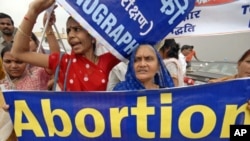More and more Indian families are using abortion to favor the birth of male babies. A new international study released Tuesday follows census data that indicates a sharp drop in the ratio of male-to-female children throughout India.
Canada's Centre for Global Health Research led the study, which examined 250,000 births in India from 1980 to 2005. Researchers were seeking trends in the number of boys versus girls being born.
The study found a dramatic drop in the number of girls being born - from an average of 906 girls per 1,000 births in 1990, to just 836 girls per 1,000 births in 2005. Professor Prabhat Jha, who led the research, said his team believes Indians are increasingly using abortion to prevent girls from being born.
“Selective abortions [have] increased in the last few decades," said Jha. "Something like, up to 12 million girls have been aborted over this three decade period - half of which appear to be just in the 2000s.”
Jha said the most dramatic declines in girl births took place in families in which a girl had already been born. Households at the top end of the income scale also had a much greater decline in female baby births than those at the bottom.
“So this is really a phenomenon of the educated and of the wealthy,” said Jha.
Researchers believe the wealthy are making greater use of selective sex abortions in India for the simple reason that they can afford access to ultrasound equipment and medical services more easily than poor families.
Preference for male children is deeply ingrained in India's traditional culture. Shailaja Chandra, former executive director of India's National Population Stabilization Fund, said a male birth often is an occasion to celebrate, whereas a female birth invites commiseration. She said part of that has to do with the fact that many Indians set aside a dowry, or gift of wealth, as an incentive to marry off the daughter into another family.
“If you're wealthy, you don't want to share your wealth. You want to keep business within the family, you want to keep landed property within the family," said Chandra. "If you do not have to give dowry, then that money can be spent on many other things - educating the son, building your house, doing all those other things.”
Chandra said most Indian families simply feel a better sense of security and certainty when a male child is born.
“A boy, they believe, will be able to look after them in old age, he will carry the name forward of the family - and that's very, very important to Indian families. And the girl just means a burden, because you will have to look after her, you will have to see that she's kept out of trouble. If you send her to school or college, you just don't know which way she's going to turn around. Whereas with a boy, the feeling at least is that you can just leave him, and what's the worst that will happen?”
Abortion is legal in India, but it is illegal for medical professionals to inform parents of their unborn baby's gender. That prohibition is difficult to enforce and extremely easy to circumvent.
Jha said the best way to confront the problem of India's unbalanced sex ratio is for media and policymakers to raise the public profile of the issue.
“The problem isn't one that you can just narrow [in] on and say we're going to try to go after the providers," said Jha. "India has such a large, and largely unregulated, private sector of medicine that it's hard to even think about how one could even get control without major reforms in how health works. The fundamental way to get around this is to have a public debate about social norms.”
Jha said 90 percent of all Indians live in states where the male-to-female ratio has become unbalanced. 2011 census data revealed earlier this year show there are seven million fewer girls under the age of six than boys in India.
Video news release from the Centre for Global Health Research, May 24, 2011:













